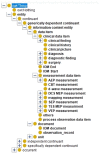An ontology-based tool for modeling and documenting events in neurosurgery
- PMID: 39085883
- PMCID: PMC11293115
- DOI: 10.1186/s12911-024-02615-y
An ontology-based tool for modeling and documenting events in neurosurgery
Abstract
Background: Intraoperative neurophysiological monitoring (IOM) plays a pivotal role in enhancing patient safety during neurosurgical procedures. This vital technique involves the continuous measurement of evoked potentials to provide early warnings and ensure the preservation of critical neural structures. One of the primary challenges has been the effective documentation of IOM events with semantically enriched characterizations. This study aimed to address this challenge by developing an ontology-based tool.
Methods: We structured the development of the IOM Documentation Ontology (IOMDO) and the associated tool into three distinct phases. The initial phase focused on the ontology's creation, drawing from the OBO (Open Biological and Biomedical Ontology) principles. The subsequent phase involved agile software development, a flexible approach to encapsulate the diverse requirements and swiftly produce a prototype. The last phase entailed practical evaluation within real-world documentation settings. This crucial stage enabled us to gather firsthand insights, assessing the tool's functionality and efficacy. The observations made during this phase formed the basis for essential adjustments to ensure the tool's productive utilization.
Results: The core entities of the ontology revolve around central aspects of IOM, including measurements characterized by timestamp, type, values, and location. Concepts and terms of several ontologies were integrated into IOMDO, e.g., the Foundation Model of Anatomy (FMA), the Human Phenotype Ontology (HPO) and the ontology for surgical process models (OntoSPM) related to general surgical terms. The software tool developed for extending the ontology and the associated knowledge base was built with JavaFX for the user-friendly frontend and Apache Jena for the robust backend. The tool's evaluation involved test users who unanimously found the interface accessible and usable, even for those without extensive technical expertise.
Conclusions: Through the establishment of a structured and standardized framework for characterizing IOM events, our ontology-based tool holds the potential to enhance the quality of documentation, benefiting patient care by improving the foundation for informed decision-making. Furthermore, researchers can leverage the semantically enriched data to identify trends, patterns, and areas for surgical practice enhancement. To optimize documentation through ontology-based approaches, it's crucial to address potential modeling issues that are associated with the Ontology of Adverse Events.
Keywords: Adverse events; Apache Jena; BFO; Knowledge base; Neurosurgery; Ontology.
© 2024. The Author(s).
Conflict of interest statement
The authors declare no competing interests.
Figures








References
-
- Zbinden C, Strickler M, Sariyar M, et al. Digitizing data management for intraoperative neuromonitoring. Stud Health Technol Inf. 2021;278:211–6. - PubMed
-
- Zbinden C, Strickler M, Sariyar M, et al. A protocol entry catalog for intraoperative neuromonitoring - steps towards an Ontology. Stud Health Technol Inf. 2020;272:318–21. - PubMed
MeSH terms
LinkOut - more resources
Full Text Sources

